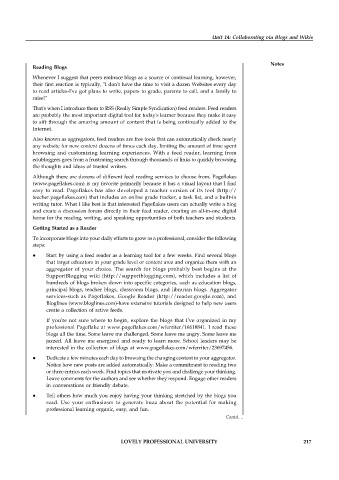Page 222 - DCAP609_CLOUD_COMPUTING
P. 222
Unit 14: Collaborating via Blogs and Wikis
Notes
Reading Blogs
Whenever I suggest that peers embrace blogs as a source of continual learning, however,
their first reaction is typically, "I don't have the time to visit a dozen Websites every day
to read articles-I've got plans to write, papers to grade, parents to call, and a family to
raise!"
That's when I introduce them to RSS (Really Simple Syndication) feed readers. Feed readers
are probably the most important digital tool for today's learner because they make it easy
to sift through the amazing amount of content that is being continually added to the
Internet.
Also known as aggregators, feed readers are free tools that can automatically check nearly
any website for new content dozens of times each day, limiting the amount of time spent
browsing and customizing learning experiences. With a feed reader, learning from
edubloggers goes from a frustrating search through thousands of links to quickly browsing
the thoughts and ideas of trusted writers.
Although there are dozens of different feed reading services to choose from, Pageflakes
(www.pageflakes.com) is my favorite primarily because it has a visual layout that I find
easy to read. Pageflakes has also developed a teacher version of its tool (http://
teacher.pageflakes.com) that includes an online grade tracker, a task list, and a built-in
writing tutor. What I like best is that interested Pageflakes users can actually write a blog
and create a discussion forum directly in their feed reader, creating an all-in-one digital
home for the reading, writing, and speaking opportunities of both teachers and students.
Getting Started as a Reader
To incorporate blogs into your daily efforts to grow as a professional, consider the following
steps:
Start by using a feed reader as a learning tool for a few weeks. Find several blogs
that target educators in your grade level or content area and organize them with an
aggregator of your choice. The search for blogs probably best begins at the
SupportBlogging wiki (http://supportblogging.com), which includes a list of
hundreds of blogs broken down into specific categories, such as education blogs,
principal blogs, teacher blogs, classroom blogs, and librarian blogs. Aggregator
services-such as Pageflakes, Google Reader (http://reader.google.com), and
Bloglines (www.bloglines.com)-have extensive tutorials designed to help new users
create a collection of active feeds.
If you're not sure where to begin, explore the blogs that I've organized in my
professional Pageflake at www.pageflakes.com/wferriter/16618841. I read these
blogs all the time. Some leave me challenged. Some leave me angry. Some leave me
jazzed. All leave me energized and ready to learn more. School leaders may be
interested in the collection of blogs at www.pageflakes.com/wferriter/23697456.
Dedicate a few minutes each day to browsing the changing content in your aggregator.
Notice how new posts are added automatically. Make a commitment to reading two
or three entries each week. Find topics that motivate you and challenge your thinking.
Leave comments for the authors and see whether they respond. Engage other readers
in conversations or friendly debate.
Tell others how much you enjoy having your thinking stretched by the blogs you
read. Use your enthusiasm to generate buzz about the potential for making
professional learning organic, easy, and fun.
Contd....
LOVELY PROFESSIONAL UNIVERSITY 217

